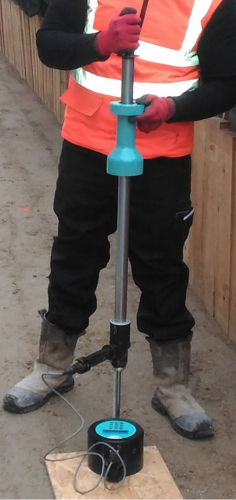
ISO 22 476-2
Penetrometer test for Geotechnical investigation and testing, Field testing, Dynamic probing, Compaction and soils investigation measuring equipment, type a soil.
Range of probe-penetrometers, light weight or heavy penetrometers, dynamic constant or variable energy penetrometers:
The DPSH test – Dynamic Penetrometer Super Heavy, is internationally standardized by the “International Reference Test Procedures for Probing Dynamic-DP” (ISSMFE 1989), the German standard DIN 4094-3 and more recently by ISO Standard – 22476- 2.
The latter standard has four types of dynamic penetrometer (light-DPL, medium-DPM, DPH-heavy and heavy-DPSH super), mainly by varying the hammer weight and drop height.
By relying on an international standard of the International Standardization Organization (ISO), of which Brazil is a signatory, as orients the Brazilian Institute of Technical Standards (INMETRO), passes the dynamic tests have regular use in Brazil, which disseminate research for these assays. The tests of the current family’s DP (Dynamic tests) have long been part of the geotechnical community worldwide, as it was from its evolution than the other dynamic and static tests also emerged.
In Brazil and in the world, there is a vast literature which records the participation of Dynamic Probing Light test (DPL) when correlated with the Standard Penetration Test (SPT) or Cone Penetration Test (CPT).
As for the DPSH, his presence is very common in Europe and South Africa, but still little used and widespread in the country. On the other hand, there are no appropriate correlations and validated in Brazil, and so to be, this work will try to propose a correlation between these two tests. The site chosen study was the urban area of the City of Joinville / SC / Brazil.
This study aims to analyze the correlation between SPT and DPSH test where primarily, we tried to analyze the results of their numerical indices in the global perspective.
Then provided with the development of geological and geotechnical maps, we evaluated the results from the perspective of interference two more present geotechnical units, as well as consideration of soil saturation, since the region has a high-water table.
The justification for the development of the work is the fact that among the members of DP’s family the DPSH is what is closest energy SPT, besides having the same dynamic principle of execution, the same depth range of conditions, advantage of having automatic firing hammer, count on high productivity, with reduced operational interference and lower running costs. As a result of comparisons studied through the use of statistics obtained strong correlation between their levels of dynamic resistance, which indicates that the proposal is valid and may be more detailed in future work where other variables may be jointly tested and studied its effects.